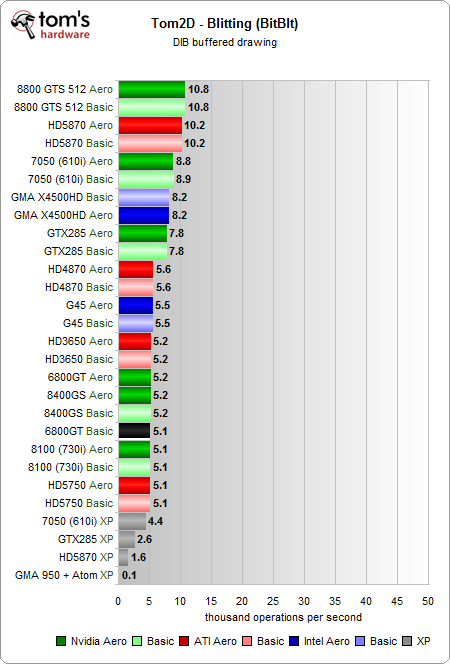Blitting is the copying of bitmap content into other bitmaps. Here, device-dependent image sections are transferred.

Content of the test
A total of 50,000 image sections of random size between 1×1 and 500×500 pixels are copied and pasted (blitted) at a random position. We alternate the copy style(copy, invert, paint). The initial value for the random generator is always identical, so all test runs always map the same content. All objects are inside the drawing area, so no clipping is needed.
Used GDI functions
for the pure blitting benchmark:
- BitBlt (copy, invert, paint).
additionally for DIB buffer (test with buffering):
- CreateCompatibleDC
- CreateDIBSection
- SelectObject
- DeleteObject
Direct drawing without buffer
Drawing with buffer
Conclusion
The blitting this time shows a general weakness of the HD 5xxx series under XP in this area. The comparative benchmark shows the same behavior as the onboard chipset 780G, which we had taken out of the test. In buffered blitting, the Atom almost goes into standstill and the two upper-class graphics cards are almost unusable under XP. Here, the HD5870 and GTX285 are on the same subterranean level.
- 1 - Einführung: Die Relevanz der 2D-Grafikausgabe über das GDI
- 2 - Das 2D-GDI und dessen Grafikausgabe von XP bis Windows 7 im Detail
- 3 - 2D-Grafikausgabe über das GDI: direkt oder gepuffert?
- 4 - Die Symptome der HD 5xxx-Serie und deren Relevanz unter Windows 7
- 5 - Tom2D: Unser einfacher 2D-GDI-Benchmark
- 6 - Tom2D: Textausgabe
- 7 - Tom2D: Linien
- 8 - Tom2D: Kurven
- 9 - Tom2D: Polygone
- 10 - Tom2D: Rechtecke
- 11 - Tom2D: Ellipsen
- 12 - Tom2D: Blitting
- 13 - Tom2D: Stretching
- 14 - Fazit



































16 Antworten
Kommentar
Lade neue Kommentare
Mitglied
Veteran
Urgestein
1
Urgestein
1
Urgestein
Urgestein
Urgestein
Urgestein
Mitglied
Urgestein
1
Urgestein
Mitglied
1
Alle Kommentare lesen unter igor´sLAB Community →